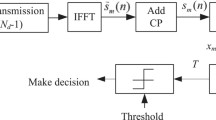Abstract
This paper proposes a low-complexity cyclostationarity feature detection scheme for detect and avoid (DAA) of Ultra-Wideband (UWB) system in order to solve the coexistence issues between UWB system and Long Term Evolution-Advanced (LTE-Advanced) system. The proposed scheme is suitable for the detection of a localized Single-carrier Frequency Division Multiple Access (SC-FDMA) signal utilized in the uplink of LTE-Advanced system. Compared with conventional cyclostationarity feature detection, the proposed scheme utilizes all possible cyclic-spectrums located in a distributed window function, which is decided by the frequency distribution of the Primary User (PU) signal. The computational complexity of the proposed scheme is low, due to only one window width instead of all occupied spectrum interval will be searched for the possible cyclic-spectrums. On the other hand, the proposed scheme can also avoid the estimation of the cyclic-spectrums when the type of PU signal is unclear or the cyclic-spectrums are hard to estimate. Simulation results indicate that the proposed scheme can make a tradeoff between detection performance and computational complexity. The low-complexity cyclostationarity feature detection also provides a substitute for the energy detection when the later approach suffers from the noise uncertainty and cannot distinguish the target signal type.
Similar content being viewed by others
References
Shetty, S., & Aiello, R. (2006). Detect and Avoid (DAA) techniques—enabler for worldwide ultrawideband regulations, Ultra wideband systems, technologies and applications, 2006. The institution of engineering and technology seminar on 2006, pp. 21–29.
ETSI Technical Specification. (2008–2011). Electromagnetic compatibility and Radio spectrum Matters (ERM);Short Range Devices (SRD); Technical characteristics of Detect-And-Avoid (DAA) mitigation techniques for SRD equipment using Ultra Wideband (UWB) technology. ETSI TS 102 754 version 1.2.1.
“Final Acts WRC-07,”Geneva (November, 2007).
Mishra S. M., Brodersen R. W., Brink S. T., Mahadevappa R. (2007) Detect and avoid: An ultra-wideband/WiMAX coexistence mechanism. IEEE Communications Magazine 45(6): 68–75
Giuliano R., Mazzenga F. (2005) On the coexistence of power-controlled ultrawide-band systems with UMTS, GPS, DCS1800, and fixed wireless systems. IEEE Transactions on Vehicular Technology 54(1): 62–81
3GPP. 3rd Generation Partnership Project; Technical Specification Group Radio Access Network; Evolved Universal Terrestrial Radio Access (E-UTRA); Physical Channels and Modulation (Release 8). 3GPP TS 36.211 version 8.7.0 (2009–05).
Tanno, M., Kishiyama, Y., Taoka, H., Miki, N., Higuchi, K., & Sawahashi, M. (2009). Layered OFDMA and its radio access techniques for LTE-Advanced, IEICE Transaction on Commununication, Vol.E92-B, no.5, pp. 1743–1750.
3GPP. 3rd Generation Partnership Project; Technical Specification Group Radio Access Network; Feasibility study for Further Advancements for E-UTRA (LTE-Advanced). 3GPP TR 36.912 version V9.2.0 (2010–03).
Cabric, D., Tkachenko, A., & Brodersen, R. W. (2006). Spectrum sensing measurements of pilot, energy, and collaborative detection, Proceedings of Military and Communication Conference (MILCOM) pp. 1–7.
Mishra, S. M., Ten Brink, S. & Brodersen, R. W. (2007). Detect and avoid: an ultra-wideband/WiMax coexistence mechanism, IEEE Communications Magazine, pp. 68–75.
Gardner W. A. (1986) Measurement of spectral correlation. IEEE Transaction on Acoustics, Speech, and Signal Processing 34(5): 1111–1123
Gardner W. A. (1988) Signal interception: A unifying theoretical framework for future detection. IEEE Transactions on Communications 36(8): 897–906
Dandawaté A. V., Giannakis G. B. (1994) Statistical tests for presence of cyclostationarity. IEEE Transaction Signal Process 42(9): 2355–2369
Öner M., Jondral F. (2007) An air interface identification for software radio systems. International journal of electronics and communications 61(2): 104–117
Punchihewa, A., Dobre, O. A., Zhang, Q., Rajan, S., & Inkol, R. (2008). The nth-order cyclostationarity of OFDM signals in time dispersive channels, Proceedings of IEEE ASILOMAR, 2008, pp. 574–580.
Wang J., Chen T., Huang B. (2006) Cyclo-period estimation for discrete-time cyclo-stationary signals. IEEE transactions on signal processing 54(1): 83–94
Halford, K., & Webster, M. (2001). Multipath measurement in wireless LANs, Intersil Application Note, AN9895.1
Schnell M. (1999) A promising new wideband multiple-access scheme for future mobile communications systems. European transaction on telecommunications 10(4): 417–427
Myung H. G., Lim J., Goodman D. J. (2006) Single carrier FDMA for uplink wireless transmission. Vehicular Technology Magazine, IEEE 1(3): 30–38
3GPP. 3rd Generation Partnership Project; Technical Specification Group Radio Access Network; Evolved Universal Terrestrial Radio Access (E-UTRA); Physical layer procedures (Release 8). 3GPP TS 36.213 version 8.8.0 (2009–09).
Author information
Authors and Affiliations
Corresponding author
Rights and permissions
About this article
Cite this article
Zhang, W., Sanada, Y. Low-Complexity Cyclostationarity Feature Detection Scheme of Localized SC-FDMA Uplink System for Application to Detect and Avoid. Wireless Pers Commun 66, 307–319 (2012). https://doi.org/10.1007/s11277-011-0341-4
Published:
Issue Date:
DOI: https://doi.org/10.1007/s11277-011-0341-4




